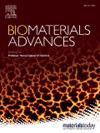在dECM诱导的模型中,COL4A2通过YAP信号通路驱动ECM重塑和刚度增加,促进乳腺癌转移
IF 6
2区 医学
Q2 MATERIALS SCIENCE, BIOMATERIALS
Materials Science & Engineering C-Materials for Biological Applications
Pub Date : 2025-07-22
DOI:10.1016/j.bioadv.2025.214430
引用次数: 0
摘要
机械应力在肿瘤进展过程中显著增加。由于机械的改变给治疗带来了很大的困难,积累的研究主要集中在机械转导上。细胞外基质(ECM)是为肿瘤细胞提供机械信号的关键组织微环境。然而,肿瘤ECM组装的机制、刚度和由此产生的细胞力学反应很少报道。本研究通过原位植入免疫缺陷小鼠乳腺脂肪垫,制备低转移性和转移性乳腺癌组织的脱细胞ECM (dECM)模型,模拟肿瘤微环境。转移性dECM纤维结构呈波浪形,纤维较细,但硬度较高。IV型胶原蛋白(COL IV)的表达升高与胶原纤维交联增加导致的细胞迁移增强和ECM刚度升高相关。进一步分析发现COL4A2 (COLIV的一个亚基)是参与这一过程的关键蛋白。病毒感染肿瘤细胞导致dECM原位COL4A2特异性降低,同时伴有ECM硬度降低,体外细胞迁移受到抑制,体内转移减少。此外,dECM支架中COL4A2含量高导致ECM刚度增加,激活了YAP1的表达,这可能是一种潜在的机制。因此,COL4A2通过胶原纤维交联促进基底膜的刚度可能是乳腺癌转移的关键机械靶点。靶向ECM机制可能提供抑制肿瘤进展的新策略。本文章由计算机程序翻译,如有差异,请以英文原文为准。

COL4A2 drives ECM remodeling and stiffness increasing to promote breast cancer metastasis via YAP signaling pathway in dECM induced models
Mechanical stress significantly increases during tumor progression. Accumulated research focuses on mechanical transduction, due to the great therapeutic difficulties brought by the mechanical changes. Extracellular matrix (ECM) serves as the key tissue microenvironment providing mechanical cues for tumor cells. However, the mechanism of tumor ECM assembly, stiffness and the resulting cellular mechanical response were rarely reported. Here, decellularized ECM (dECM) models from low-metastatic and metastatic breast cancer tissues via in situ tumor implantation of mammary fat pad in immunodeficient mice were generated to simulate the tumor microenvironment. Wavy fiber structure, finer fibers, but higher stiffness were revealed in the metastatic dECM. Elevated expression of type IV collagen (COL IV) was correlated with the enhanced cell migration and the higher ECM stiffness due to the increased crosslinking of collagen fibers. Further analysis identified COL4A2 (a subunit of COLIV) as a key protein involved in this process. Virus infection of tumor cells led to a decrease in COL4A2 specificity in the dECM in situ, accompanied by the decreased ECM stiffness, the inhibition of cell migration in vitro, and the reduction of metastasis in vivo. Additionally, the increased ECM stiffness caused by the high content of COL4A2 in dECM scaffolds activated YAP1 expression, which might be a potential mechanism. Therefore, the promotion of the stiffness in the basement membrane by COL4A2 via collagen fiber cross-linking might be a key mechanical target for breast cancer metastasis. The targeting ECM mechanics could offer a new strategy to inhibit tumor progression.
求助全文
通过发布文献求助,成功后即可免费获取论文全文。
去求助
来源期刊
CiteScore
17.80
自引率
0.00%
发文量
501
审稿时长
27 days
期刊介绍:
Biomaterials Advances, previously known as Materials Science and Engineering: C-Materials for Biological Applications (P-ISSN: 0928-4931, E-ISSN: 1873-0191). Includes topics at the interface of the biomedical sciences and materials engineering. These topics include:
• Bioinspired and biomimetic materials for medical applications
• Materials of biological origin for medical applications
• Materials for "active" medical applications
• Self-assembling and self-healing materials for medical applications
• "Smart" (i.e., stimulus-response) materials for medical applications
• Ceramic, metallic, polymeric, and composite materials for medical applications
• Materials for in vivo sensing
• Materials for in vivo imaging
• Materials for delivery of pharmacologic agents and vaccines
• Novel approaches for characterizing and modeling materials for medical applications
Manuscripts on biological topics without a materials science component, or manuscripts on materials science without biological applications, will not be considered for publication in Materials Science and Engineering C. New submissions are first assessed for language, scope and originality (plagiarism check) and can be desk rejected before review if they need English language improvements, are out of scope or present excessive duplication with published sources.
Biomaterials Advances sits within Elsevier''s biomaterials science portfolio alongside Biomaterials, Materials Today Bio and Biomaterials and Biosystems. As part of the broader Materials Today family, Biomaterials Advances offers authors rigorous peer review, rapid decisions, and high visibility. We look forward to receiving your submissions!

 求助内容:
求助内容: 应助结果提醒方式:
应助结果提醒方式:


